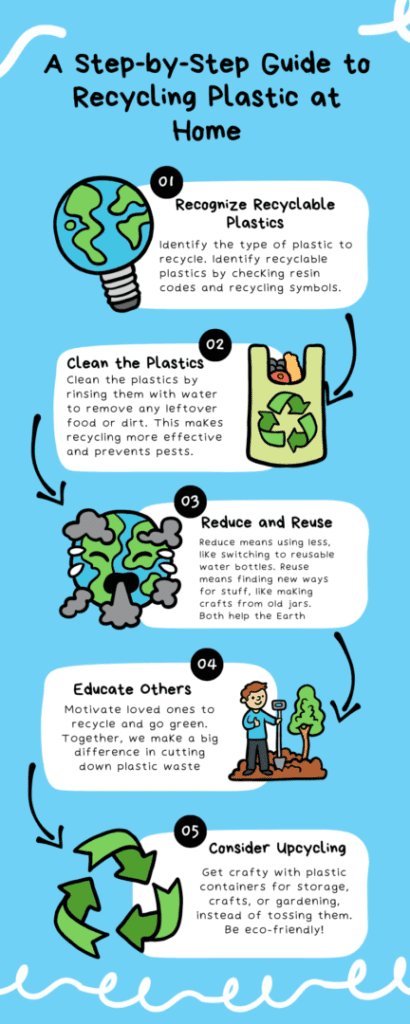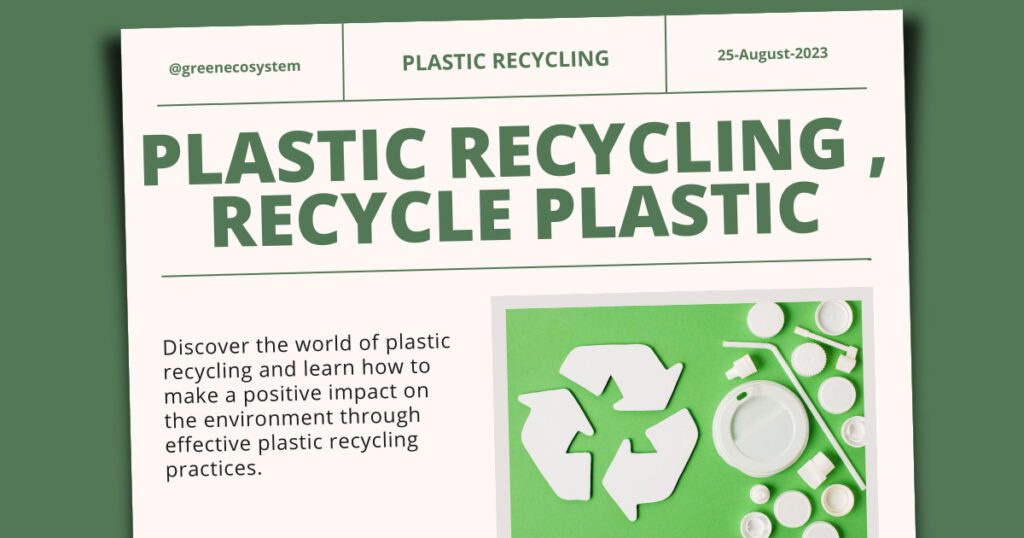Understanding the Importance of Plastic recycling
Plastic recycling stands as a critical process, breathing new life into discarded plastic materials and steering them towards a purposeful second act. It is an essential tool in our arsenal against plastic waste and its damaging consequences on our environment. The value of plastic recycling lies not only in its conservation of resources but also in its reduction of the energy needed to craft fresh plastic products. In this exploration, we will delve into the pivotal role that recycling plastic plays and the multitude of benefits it offers to our environment. So, let’s embark on this enlightening journey.
Why is Plastic Recycling So Crucial?
Minimizing the Environmental Impact of Plastic Waste
Recycling, across the board, is a linchpin of environmental sustainability. By recycling materials like plastic, paper, glass, and metal, we achieve a multitude of wins. First and foremost, we conserve natural resources, diminish energy consumption, and curtail greenhouse gas emissions. Furthermore, recycling is a potent strategy for diverting waste away from landfills, thereby reducing pollution and safeguarding precious land.
In addition, it champions the idea of a circular economy, a realm where materials are reused and repurposed, resulting in decreased raw material extraction and energy savings in the production cycle. By adopting recycling as a collective duty, we empower ourselves to be stewards of the planet, mitigating the harmful consequences of excessive waste generation, and paving the way for a cleaner, greener, and more sustainable world.
The Significance of Recycling Plastic
A Resolute Answer to Mounting Plastic Waste
The production of plastic has surged over the years, leading to a corresponding surge in plastic waste. Recycling plastic emerges as a formidable response to this environmental challenge.
- Resource Conservation: Recycling plastic cuts down the necessity for fresh raw materials, like petroleum, a core ingredient in most plastics. By repurposing existing plastic materials, we effectively conserve precious natural resources and reduce the demand for fossil fuel.
- Effective Waste Management : Recycling plastic ensures it doesn’t end up in landfills or go through incineration, both of which carry adverse environmental and health implications.
- Reduced Greenhouse Gas Emissions: The production of new plastic requires a substantial amount of energy. Conversely, recycling plastic consumes far less energy, leading to decreased carbon emissions.
Benefits of Recycling Plastic
A Bounty of Rewards for Our World
Recycling plastic showers our environment and society with an array of benefits:
- Environmental Preservation: Recycling plastic lessens the pollution stemming from plastic disposal, reducing contamination of water, air, and soil. It contributes to safeguarding ecosystems and wildlife by preventing plastic waste from infiltrating natural habitats.
- Energy Conservation: The energy saved by recycling plastic can be directed toward other critical purposes, helping reduce overall energy demand.
- Economic Opportunities: The recycling industry generates job opportunities and stimulates economic growth, contributing to the welfare of our communities.
- Circular Economy: Recycling plastic aligns with the concept of a circular economy, where resources enjoy extended life cycles. By recycling plastic, we close the loop and propel the shift towards a more sustainable and resource-efficient society.
A Step-by-Step Guide to Recycling Plastic at Home
Empowering Environmental Action Right at Home
Recycling plastic at home can be straightforward and eco-friendly. Here’s a step-by-step guide for young environmental enthusiasts:
- Identify Recyclable Plastics: Look for recycling symbols and numbers (resin identification codes) on the bottom of plastic containers. Focus on plastics with recycling symbols.
- Clean the Plastics: Rinse plastic containers thoroughly to remove food residues and contaminants, ensuring an effective recycling process and deterring pests.
- Separate by Resin Codes: Group plastic containers with the same resin identification codes together, as they can often be recycled together. Different types may require separate recycling processes.
- Check Local Guidelines: Be aware that recycling capabilities may vary by location. Consult your local municipality or waste management authority to understand which plastics are accepted for recycling in your area.
- Use Curbside or Drop-off: If available, follow curbside recycling guidelines in your community. If not, find the nearest recycling drop-off centers where you can deposit your recyclables.
- Reduce and Reuse: While recycling is vital, aim to reduce and reuse plastic whenever possible. Opt. for reusable items like water bottles, shopping bags, and food containers to minimize single-use plastic waste.
- Consider Upcycling: Get creative with plastic containers and find ways to upcycle them for storage, crafts, or gardening projects instead of disposing of them.
- Avoid Contamination: Only recycle clean and empty plastic containers. Do not place non-recyclable or contaminated items in the recycling bin, as they can disrupt the recycling process.
- Educate Others: Encourage your family and friends to join in recycling efforts and embrace sustainable practices. Awareness and collective action can have a significant impact on reducing plastic waste. Remember, recycling is just one piece of the puzzle. Reducing plastic consumption and responsibly managing waste are equally vital steps in preserving our environment

Exploring Recycled Plastic Products
Sustainable Innovations from Repurposed Plastic
Recycled plastic products offer a fantastic way to champion sustainability and combat plastic waste. Here are some intriguing examples:
- Reusable Water Bottles: These bottles, crafted from recycled plastic, are durable, free from harmful chemicals, and reduce the need for single-use plastic bottles.
- Outdoor Furniture: Sturdy, weather-resistant furniture made from recycled plastic provides a sustainable alternative to traditional materials.
- Clothing and Accessories: Fashion items like clothing, online shopping bags, and shoes crafted from recycled plastic promote eco-friendly fashion choices.
- Eco-friendly Building Materials: Innovative materials such as recycled plastic lumber and composite decking materials offer sustainable alternatives to traditional wood.
- Home Decor: Recycled plastic can be transformed into rugs, mats, storage containers, and kitchen utensils, adding an eco-friendly touch to your home.
- Technology Accessories: Phone cases, laptop sleeves, and headphones made from recycled plastic protect your devices while supporting sustainable practices.
Availability of these products may vary by location and brand, so check with local retailers, sustainable brands, or online marketplaces for a wide range of options.
As young students, you have the power to be informed consumers and champions of environmental responsibility. Recycling plastic is not just an action; it’s a step toward a brighter, greener future for our planet.

